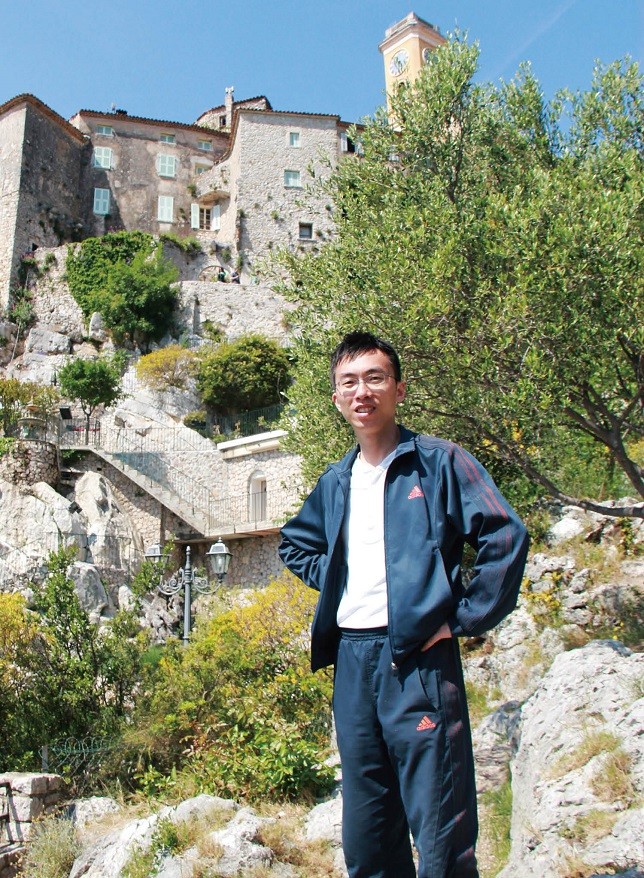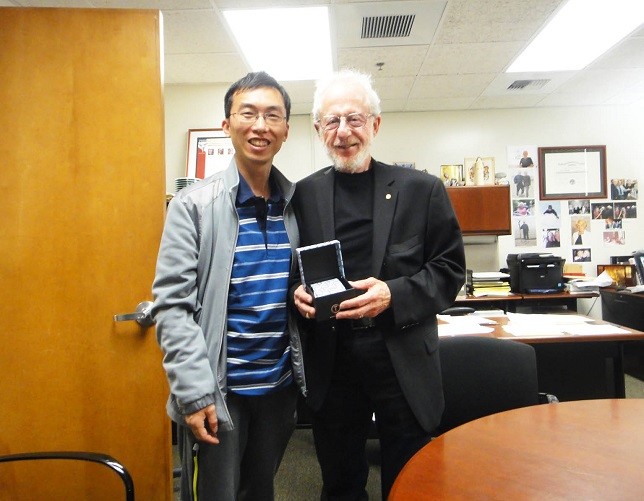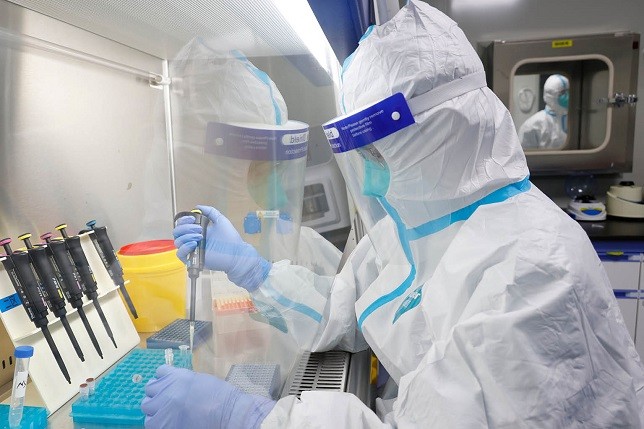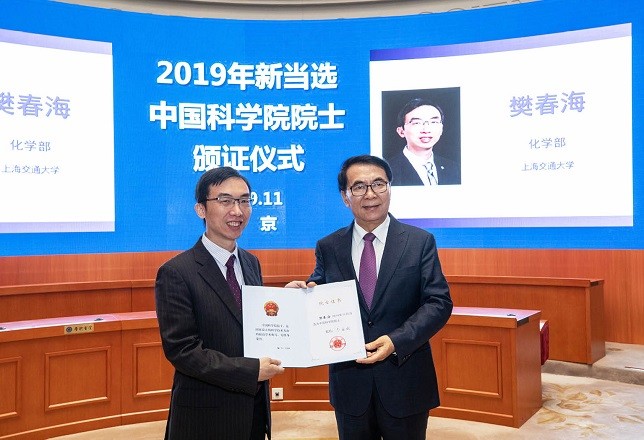Fan Chunhai: Post-70s academicians span three fields.
26-year-old, Ph.D. in biochemistry and molecular biology from Nanjing University. At the age of 33, he was supported by the Outstanding Youth Fund of the National Natural Science Foundation of China. At the age of 42, the carrying team developed a new method for inducing nano-scale precise mineralization by DNA self-assembly structure and published it in Nature, which achieved the first major breakthrough in the field of DNA nanotechnology by China researchers. In the last seven years, he has been selected as one of the "highly cited scientists in the world". At the age of 45, he was elected as an academician of China Academy of Sciences, and he is currently the youngest academician in Shanghai.
He is Professor Wang Kuancheng from the School of Chemistry and Chemical Engineering of Shanghai Jiaotong University and Fan Chunhai, Executive Dean of the Institute of Translational Medicine of Shanghai Jiaotong University, a cross-border scientist who spans many fields of chemistry, physics and medicine.
Fan Chunhai’s current office is located in the Translational Medicine Research Center of Shanghai Jiaotong University. Next to the simple and bright office is a uniform laboratory. The experimental platform is filled with all kinds of equipment, and there are few other colors except black and white. All this just coincides with his character of dealing with people-determined, methodical and courageous. An interview with him by Xinmin Weekly was recently held in his office.
Establish the first international RNA nucleic acid detection standard

Fan Chunhai, who was elected as an academician of Chinese Academy of Sciences in 2019, has been devoted to basic research fields such as DNA self-assembly, DNA storage and molecular machines, and has made remarkable achievements. In recent years, he began to focus on transforming basic research results into clinic and seeking well-being for human health.
At the beginning of 2020, a sudden COVID-19 epidemic plunged the world into a great panic. It is one of the most effective means to quickly confirm the infected person by nucleic acid detection. Fan Chunhai, who has been dealing with nucleic acids for more than 20 years, is the hero behind this technology.
Just after the Spring Festival in 2020, Fan Chunhai coordinated and organized the joint research team of Jiaotong University and Shanghai Institute of Metrology, and began to work hard day and night, finally overcoming the technical difficulties of unstable RNA reagents. After more than 40 days of unremitting efforts, the first international standard substance for RNA nucleic acid detection was established. Fan Chunhai said that this is like a weight on a balance, which requires a clear measurement standard. The latest research results of this joint research are provided free of charge by Shanghai Metrology Institute to many nucleic acid reagent manufacturers and medical institutions. A total of more than 1000 bottles of COVID-19 RNA standard materials were distributed to more than 100 units including Shanghai Customs, Shanghai CDC, Wuhan CDC, Ruijin Hospital and Shanghai Zhijiang Biotechnology Company.
With long-term accumulation and team strength, the basic research results can finally be transformed into practical applications, and the key moment is to share the worries of the country and benefit the people. As a scientific research worker, Fan Chunhai feels gratified.
At present, the Institute of Translational Medicine of Shanghai Jiaotong University, led by Fan Chunhai, carries the construction and operation of the country’s major scientific and technological infrastructure of translational medicine. He hopes that through this platform, more new methods of nucleic acid detection will be transformed into clinic, and early detection including infectious diseases and cancer will be realized through this platform.
At present, middle-aged and older men in physical examination have been generally screened for prostate cancer markers. However, common physical examination indicators are often difficult to distinguish benign lesions from canceration. Fan Chunhai is exploring better tumor markers than common detection methods, which is expected to become a new generation of prostate cancer markers. At present, the research results of this new method for early screening of prostate cancer are being actively carried out in clinical trials with Renji Hospital.
Fan Chunhai knows that there is a huge gap between basic research and clinical application of real medicine. His greatest hope is to build a bridge and fill this gap by transforming a national platform such as medical facilities.
DNA origami, a new use of DNA
Another important basic research direction of Fan Chunhai is DNA origami.
We are all familiar with DNA and know that DNA is the code of life, but you may not know that it can be knitted like a sweater and assembled like Lego. This technique is called DNA origami.
Different from the traditional DNA assembly technology, DNA origami can controllably construct highly complex nano-patterns or structures by base complementation between a long DNA single strand and a series of short DNA fragments.
In 2006, American scientist Paul Rothemund bent and folded a smiling face with a long DNA chain of 7,000 base pairs. Fan Chunhai was one of the earliest scientists who participated in the research of DNA origami. Also in 2006, he and Academician He Lin of Shanghai Jiaotong University constructed a map of China based on the principle of DNA origami technology, which became the second published achievement in this field.
Now, scientists can use DNA origami to make our genetic material into various shapes, such as the national treasure panda. Fan Chunhai pointed out that in nature, DNA exists not only in the form of double helix, but also in various forms of DNA and RNA nucleic acid, including ring and rod. "We can think of DNA as a very soft wool. When it collides with hundreds of short-chain fragments and is assembled together, it can be woven into any shape we want just like wool."
In Fan Chunhai’s view, the naming of DNA origami is a beautiful misunderstanding. "Americans don’t understand knitting sweaters. He thinks it is origami, so he named this technology origami. This is a wrong start, but it brings beauty and prosperity to an entire field. "
It has been 15 years since 2006, and scientists’ DNA origami can also construct various nano-scale shapes from one to two and then to three, just like 3D printing. So, what can we do with these shapes?
Fan Chunhai pointed out that in the macro world, one of the most useful materials for human beings is frame materials. Similarly, in the nano-world, coding the AGTC letters of DNA into some framework substances can make some biomolecules, such as nucleic acid itself, aptamers, antibodies, protein, enzymes and other substances live in the nano-house built by DNA framework. This is the latest definition put forward by Fan Chunhai-the framework structure made of DNA is called framework nucleic acid.
This is a kind of artificially designed structural nucleic acid, whose size, morphology and mechanical properties can be programmed, that is, we can make it as fine as a bird’s nest by programming the four letters AGTC. With this home, we can provide structural support for elements such as nucleic acid, protein and antibody, so that we can do better early detection of cancer, do better cancer treatment, or provide better tools for the diagnosis and treatment of neurodegenerative diseases such as Alzheimer’s disease.
In 2019, Fan Chunhai’s team summarized this academic thought in the journal Nature Chemistry. On the occasion of its 10th anniversary, it invited more than 50 international scientists to jointly write "The Road to Chemistry" to discuss the future challenging problems in the field of chemistry. Among them, Fan Chunhai’s challenging question in the field of chemistry is: "An exciting frontier of the discipline is to understand how artificially designed nucleic acid structures are assembled and play a role in living cells and animals. Creating new tools to control the assembly process of natural and artificial nucleic acid molecules in living cells will probably bring revolutionary changes to the field of nucleic acid chemistry, thus promoting the development of nano-diagnosis and treatment and precision medicine. In the longer term, another promising research direction is to explore and develop DNA or RNA robots with artificial intelligence and work in animals and humans. "
Fan Chunhai’s team wrote an entry: We don’t use the genetic information of DNA, but its structural information, and use its three-dimensional structure to serve our life itself.
After decades of hard work, people can now make a very complicated molecular machines. But as far as cells are concerned, these machines based on organic molecules cannot function on the surface of solutions or in human cells. Molecular machines’s protein is assembled and decomposed in cells in a highly conservative way, but it is difficult to achieve this level of intelligence by organic synthesis.
At present, Fan Chunhai’s team has made an intelligent DNA navigator embedded with depth-first search program through DNA assembly technology. This means that DNA robots can solve mazes on the surface of two-dimensional DNA.
In the latest research, Fan Chunhai’s team also developed an intelligent DNA nanorobot that can enter living cells.
"It is still a dream to have a DNA nanorobot that can be used for treatment. I personally think that one day, we will have DNA-based machines, DNA-based self-assembly machines and DNA-based nano-robots to treat diseases in the human body, thus changing people’s views on diseases and diagnosis and treatment. "
How do cross-border scholars refine?

In the results of the co-election of academicians of China Academy of Sciences, Fan Chunhai belongs to the Ministry of Chemistry; In 2019, he won the most influential award in the field of life sciences in China-the Tan Jiazhen Prize for Innovation in Life Sciences, and the work unit he chose after returning to China was the Shanghai Institute of Applied Physics of Chinese Academy of Sciences. The scope of "cross-border" seems a bit large. In this regard, Fan Chunhai’s explanation is: "The subject field and research direction are different concepts. My research direction has not changed for more than 20 years. I have been engaged in basic research on biosensing since I was a graduate student, just to explore the unknown world and need a broader vision. "
In 1992, Fan Chunhai, who was preparing to take the college entrance examination, applied for the Department of Biochemistry of Nanjing University. "At that time, the choice of biochemistry was blind and I didn’t understand it at all. But I vaguely feel that biochemistry has both biology and chemistry. This name is cool! " Fan Chunhai recalled.
When Fan Chunhai was studying at Nanjing University, there was a strong interdisciplinary atmosphere in the Department of Biochemistry. The slogan of the department was "If you can’t learn chemistry well, you can’t do biochemistry well". Zhu Dexu, one of the pioneers of biopharmaceutical technology research and development in China and the founder of heparin and urokinase industry, was then the head of the department, and Li Genxi, a doctoral student of China Academy of Sciences, the pioneer of the concept of life analytical chemistry and the founder of the State Key Laboratory of Life Analytical Chemistry, taught in the Department of Biochemistry. Fan Chunhai was guided by teachers during his graduate studies, and started at the intersection of two academic inheritance lines of biochemistry and life analytical chemistry, engaged in the research of electrochemical biosensors, which was a frontier interdisciplinary subject at that time.
To keep advancing in frontier disciplines, we must know more about the international scientific research trends. "When I was studying, I often needed to read foreign literature. Unfortunately, the literature I saw at that time would lag behind at least half a year." Fan Chunhai came across an exclusive interview with Professor Alan Alan Heeger (winner of the Nobel Prize in Chemistry) of the University of California, Santa Barbara (UCSB) in Advanced Materials magazine. Haig said: After winning the Nobel Prize, I hope to do something I didn’t dare to do before, such as biology, especially biosensing is the most important thing. Fan Chunhai had a feeling of hitting it off, and immediately applied to Professor Haig for a postdoctoral position, which was finally recognized.
After coming to the beautiful coastal city of Santa Barbara, California, Fan Chunhai discovered that Haig was actually a professor of physics, and he always considered himself a physicist. A physicist won the Nobel Prize in chemistry and then started to do biology, which made Fan Chunhai feel very shocked. Many years later, Professor Haig said modestly in a speech in China: "I knew nothing about biology at that time, and even the most basic knowledge such as DNA molecules was taught by Chunhai."
The postdoctoral experience in Haig Laboratory made Fan Chunhai step into the frontier of interdisciplinary from a fledgling young researcher. "What impressed me most was that Professor Haig had a very broad vision of the problem, and he especially respected interdisciplinary." Fan Chunhai said that working in Haig’s laboratory requires multiple scientific research projects at the same time, which once overwhelmed him. "You just pick the most important thing to do." The tutor’s words made Fan Chunhai enlightened, and have always guided him to make judgments.
Under the guidance of Professor Haig, Fan Chunhai has made some research progress, and related research work has been published in authoritative magazines such as Proceedings of the National Academy of Sciences (PNAS) and Journal of the American Chemical Society (JACS). Among them, an electrochemical DNA biosensor named E-DNA has been developed, which has been widely praised by international peers. American Chemical Society C&E News rated it as one of the important chemical progress in 2003.
The postdoctoral experience has greatly broadened Fan Chunhai’s horizons and strengthened his confidence in interdisciplinary research. At that time, China was in the initial stage of discipline construction and needed a lot of new blood. In January 2004, Fan Chunhai joined sinap.
Coincidentally, on the day of his entry defense, the Shanghai synchrotron radiation light source project undertaken by the institute was approved after ten years of hard preparation. This was the largest scientific research facility in China at that time, which attracted worldwide attention. That night, firecrackers exploded to celebrate. Fan Chunhai immediately decided to choose the Institute of Applied Physics and signed the contract the next day. Guided by what was later called "Shanghai Light Source Spirit", this internationally advanced synchrotron radiation light source was completed in only five years. In 2009, Nature magazine reported on the topic "China entered the world-class synchrotron radiation club".
And these five years are exactly the five years that Fan Chunhai started from scratch and built the laboratory from scratch. Fan Chunhai, inspired by the spirit of Shanghai Light Source, hopes to do research work with the same international influence. Mr. Li Mingan and researcher Hu Jun of the Institute are early explorers in the cross-research of nano-biology in China. With their guidance and help, Fan Chunhai, combined with his own background in DNA research, gradually made it clear that DNA nanotechnology was the starting point to form research characteristics. This multidisciplinary research team, which integrates physics, chemistry and biology, has a unique interdisciplinary research atmosphere, which not only enables biosensor research to advance rapidly, but also broadens more frontier research directions.
After years of accumulation, Fan Chunhai’s team developed a new method to induce nano-scale precise mineralization by DNA self-assembly structure, which significantly improved its mechanical properties under the premise of maintaining the exquisite design of DNA nanostructures, and opened a new door for the construction and analysis of bionic nano-channels. This work was published in the journal Nature in 2018, which achieved the first breakthrough of China researchers in the field of DNA nanotechnology.
In this year, Fan Chunhai officially joined the School of Chemistry and Chemical Engineering of Shanghai Jiaotong University as Professor Wang Kuancheng. Fan Chunhai built the laboratory of "Framework Nucleic Acid Design and Nano-medical Diagnosis and Treatment" based on the newly completed national major scientific and technological infrastructure of translational medicine. Translational medicine facilities have gathered a group of experts from physics, chemistry, biology, medicine and even data science, because many new theories and technologies have emerged at the edge or intersection of disciplines.
This is a new starting point and a new journey. Fan Chunhai hopes that on the basis of more than 20 years of basic research on biosensing, the developed new method of nucleic acid analysis will be transformed and applied in practical clinic, and the possibility of low-cost medical detection will be explored, which will provide convenience for "sensing life" and escort people’s health.

Curiosity brings innovation challenges.
Fan Chunhai said that he was "not very clever" but "very curious". "Some people like to study one thing very much; There is another kind of people, such as me, who are curious and find this interesting and that interesting, so they do something overlapping. I once joked with middle school students. If you are not very smart, it is good to be an interdisciplinary subject, at least for me. "
On the surface, it seems that interdisciplinary subjects need to know something about everything, more chemistry in biology and more biology in chemistry, but on the other hand, it is not easy to really do a good job of crossing. "In fact, you have to have a deeper understanding of both disciplines, not superficial, just content to cross it. It takes a long time to explain and solve the important problems of another subject with the content of one subject. It is easy to do it, but it is not easy to do it well. "
At present, Fan Chunhai began to care about "semiconductor synthetic biology" again.
The so-called synthetic biology, in fact, regards life and cells as a computer, which contains circuits, memories and CPU. On the basis of cell circuits, scientists make innovative drugs, functional materials and energy substitutes through artificial design. "Some people say that synthetic biology can realize artificial life. This is a revolution in scientific thinking of biology and a brand-new development of life science. In 2018, three pioneers of synthetic biology have won the Nobel Prize."
Fan Chunhai said that the semiconductor synthetic biology was actually deployed by the American Semiconductor Alliance in 2013, representing the integration of information technology and biotechnology. After the road map of semiconductor synthetic biology was released in 2018, the relevant ministries and commissions in China felt very important and immediately organized personnel to start research. "It is a little later than the United States, but everyone thinks this is a very important thing and we should do it."
It is found that DNA big data storage is the core issue of semiconductor synthetic biology in the roadmap of semiconductor synthetic biology. Subsequently, DNA big data storage, quantum computing, quantum communication, etc., as representatives of cutting-edge technologies, were written into the national "14 th Five-Year Plan", and the state indicated that it would speed up the layout.
In 2020, the world’s data will be 44 ZBs, or 440 trillion bytes, and will reach 1,750 trillion bytes by 2025. In order to save these 44 ZB data in the world, the electricity consumption may be the power generation of the entire Three Gorges Dam, and in addition, the manpower, material resources, financial resources and land occupation that need to be paid are very big problems. 90% of such a large amount of data is "cold data" that is rarely called, but it must be saved. This is a great challenge for electronic storage, because the life of electronic storage technology can only be in the order of decades.
Not only storage, but also transmission has become a huge problem. In 2019, the black hole data was released, forming a very beautiful black hole pattern. The data it collects in one night is 5 PB, and it takes 10,000 hard disks to save it. There is almost no way to transmit it by Internet, but to transport it by plane, which has surpassed our traditional understanding of data. With the increasing amount of data collected, how should the data be transmitted?
Fan Chunhai said that under such challenges, DNA data storage has sprung up suddenly, and everyone thinks that the prospect is infinite, because DNA is the four bases of A, T, C and G. If it is synthesized, it is actually the process of encoding and writing information. With sequencing technology, information can be read and decoded.
But in 1988, when someone proposed to use DNA to store information, everyone thought it was a scientist’s whimsy and could not see any application scenarios. In 2015, Microsoft first proposed to use DNA as information storage. In 2018, they realized 200 megabytes of storage for the first time. In 2019, Huawei announced the roadmap of Innovation 2.0 and proposed four technologies that will change the future, one of which is to invest in DNA storage and break through the capacity limit of data storage.

"The data of 10 million hard disks can be saved with 50 grams of DNA and taken away with you. The data of 44 ZBs around the world can be saved with 200 kilograms of DNA." Fan Chunhai said that this is a completely subversive new technology that can meet the needs of data explosion. This technology brings ultra-high density, ultra-long service life, ultra-low energy consumption and super anti-interference ability. Of course, there are still great challenges in the realization of DNA storage technology, such as writing speed, writing cost and reading mode, but this is both a challenge and an opportunity.
From macro to micro, many things that we seem to be just imagination are extremely challenging international frontier scientific topics in Fan Chunhai’s scientific world, which contain passwords that change our lives. In Fan Chunhai’s view, "science itself has no disciplinary boundaries. What technology you use, physics or chemistry, or nanotechnology, etc., is actually not so important. What is important is that you discover some new methods and use some new technologies to observe and decipher the mysteries of life." (Reporter Chen Bing) (This column is co-organized: Shanghai Science and Technology Popularization Volunteers Association)